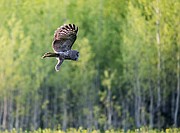An evening with a great gray owl
The great gray owl glided across the meadow on silent wings and landed on a snag right in front of me. The largest owl in Glacier National Park, great grays stand nearly three feet tall and are a rare sight. According to Cornell University’s “All About Birds,” great grays dwarf most owls in size, but not weight — they’re mostly feathers.
The feathers are not only quiet — they’re insulation. The great gray is feathered from head to toe, keeping it warm even in the coldest winters. A typical adult weighs only 2.5 pounds.
Great grays have phenomenal hearing and even when hunting in daylight, they use their ears.
Like the barn owl and long-eared owl, they have asymmetrical ear openings that help them find prey by sound alone. The left ear opening is higher on the head than the right ear opening, which enables precise directional hearing and lets them nab invisible prey, All About Birds notes.
This particular pair apparently had a nest nearby. Hidden in a dense spruce forest, they could be seen carrying prey back to the nest.
The owls don’t build their own nest, but take over an old nest from another species, like a raven, hawk or in some cases, even a squirrel. The owls are circumpolar and are also found in Scandinavia, Russia, Siberia and Mongolia, according to All About Birds.
In Glacier, they can be found both west and east of the divide. They hunt at night and at dawn and dusk. These photos were taken with a 400 mm telephoto lens, equivalent to an 8x binocular, as the owl hunted a meadow at dusk.







